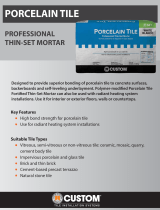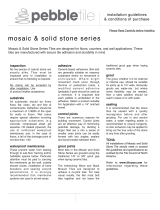Page is loading ...

ReliaBond®ProfessionalTileAdhesive/TDS189
1 Product Name
ReliaBond®ProfessionalTileAdhesive
2 Manufacturer
Custom Building Products
Technical Services 10400 Pioneer Boulevard, Unit 3
Santa Fe Springs, CA 90670
Customer Support: 800-272-8786
Technical Services: 800-282-8786
Fax: 800- 200-7765
Email: [email protected]
custombuildingproducts.com
3 Product Description
Anallpurposeproformulaadhesive,ReliaBond®isformulatedfor
use on wall, floor and countertop installations of ceramic and stone
(walls only) tile. The smooth, creamy acrylic formula spreads easily
and offers great slip resistance on vertical applications. Exceeds ANSI
A136.1 Type I requirements for organic adhesives. Suitable for
intermittently wet areas such as tub surrounds or shower walls.
Recommended for tile up to 8" (20 cm) on any side. Can be used with
wall or countertop tile up to 15" (38 cm) on any side but dry time
significantly increases. For tile with any side greater than 15" (38 cm)
CUSTOM recommends using a polymer modified thinset mortar for
setting large format tile. Call Technical Services for more information
at 800-282-8786.
Key Features
For walls, floors and countertops
Smooth, easy to trowel
Ideal for small format tile
Suitable Tile Types
Vitreous, semi-vitreous or non-vitreous tile: ceramic impervious
porcelain, mosaic, quarry tile, slate and natural stone.
Suitable Substrates
Concrete, mortar beds, masonry, Portland cement plaster
WonderBoard®Lite, cement backerboards
Exterior Grade Plywood (EGP) interior residential and light commercial
dry areas
Gypsum wallboard (interior dry areas)
Existing ceramic tile
Fully-bonded sheet vinyl flooring
Plastic laminates
Cutback adhesive (see preparation instructions)
Composition of Product
Proprietary blend of acrylic copolymers, calcium carbonate and
inorganic materials.
Benefits of Product in the Installation
High bond strengths for 8" x 8" (20.3 cm x 20.3 cm) floor tile
Meets ANSI A136.1, Type 1 requirements for intermittent water
exposure
Limitations to the Product
Recommended floor tile size: 8" (20 cm) or less on all sides.
If dry time is a concern due to tile size or other limitations, use a
traditional polymer modified thinset mortar instead.
Do not bond directly to hardwood, Luan plywood, particle board,
parquet, cushion or sponge-back vinyl flooring, metal, fiberglass,
plastic or OSB panels.
When setting moisture sensitive natural stone, cement or agglomerate
tile,checkwithCustomTechnicalServices;useEBMLite™Epoxy
BondingMortar100%SolidsorCEGLite™100%SolidsCommercial
Epoxy Grout.
Not recommended for installing tile larger than 6"x6" over
waterproofing membranes and vinyl floors.
Donotusetoinstallresinbackedmarbleofstone;useEBMLite™
EpoxyBondingMortar100%SolidsorCEGLite™100%Solids
Commercial Epoxy Grout.
Recommended for interior use only. Do not use for steam rooms,
showerfloorsorunderwater.Forthoseinstallations,useCUSTOM®
Polymer-Modified Mortar Systems.
Not for use over radiant heat systems.
Installation dry time varies depending on tile size and density,
substrate porosity and ambient conditions.
Do not use to install fixtures, ungauged natural stone, gauged stone
thicker than 3/8" (9.5 mm), transparent glass tile, translucent stone,
Saltillo pavers or lug back tile on floors.
Packaging
3.5 gal (13.25 L) pail
Color: White
4 Technical Data
Applicable Standards
American National Standards Institute (ANSI) ANSI A108.4 and
A136.1, Type 1 American National Standards for the Installation of
Ceramic Tile
Tile Council of North America (TCNA) TCNA Handbook for Ceramic Tile
Installation, TCNA Method EJ171
ReliaBond®ProfessionalTileAdhesive
Published Date: 3/28/2018

ReliaBond®ProfessionalTileAdhesive/TDS189
Technical Chart
Property Test Method Requirement Typical Results
Open Time 60 Minutes
Adjustment Time 45 Minutes
Freeze-Thaw Stability Stable
Shear Bond Strength
7 Day Dry A136.1
Section 6.2.3.1
> 50 psi Pass
28 Day Dry A136.1
Section 6.2.3.3
> 50 psi Pass
Type I After Water
Immersion
A136.1
Section 6.2.3.2
> 50 psi Pass
Heat Resistance A136.1
Section 6.2.3.5
> 10 lbs. per
tile
Pass
Impact Resistance A136.1
Section 6.2.3.6
Tile Remain
Bonded
Pass
Staining A136.1
Section 6.3
< 70%
Penetration
Pass
Resistance to Mold
Growth
A136.1
Section 6.4
No Growth Pass
Environmental Consideration
Custom®BuildingProductsiscommittedtoenvironmental
responsibility in both products produced and in manufacturing
practices.UseofthisproductcancontributetowardsLEED®v3
certification:
Up to 2 points towards MR Credit 5, Regional Materials
Upto1pointtowardsIEQCredit4.1,LowEmittingMaterials–
Adhesives & Sealants
5 Instructions
General Surface Prep
USE CHEMICAL-RESISTANT GLOVES, such as nitrile,
when handling product.
Surfaces must be structurally sound, clean, dry and free from grease,
oil, dirt, curing compounds, sealers, adhesives or any other
contaminant that would prevent a good bond. Glossy or painted
surfaces must be sanded, stripped and cleaned of waxes, dirt or any
contaminants. Concrete must be cured 28 days and accept water
penetration. Concrete must be free of efflorescence and not subject to
hydrostatic pressure. Concrete slabs should have a broomed or
brushed finish to enhance the bond. Plywood flooring including those
under resilient flooring must be structurally sound and meet all ANSI
and deflection requirements. For questions about proper subfloor
installation, call Technical Services. Smooth concrete surfaces, existing
glazed tile, terrazzo, or polished stone should be roughened or
scarified. Sheet vinyl must be well-bonded and stripped of old finish.
Roughen the surface by sanding or scarifying, rinse and allow to dry.
Expansion joints should never be bridged with setting material. Do not
sand flooring materials containing asbestos. Ambient temperature,
surfaces and materials should be maintained at a temperature above
50°F(10°C)orbelow100°F(38°C)for72hours.
Bonding to Concrete Surfaces
Concrete or plaster must be fully cured and accept water penetration.
Test by sprinkling water on various areas of the substrate. If water
penetrates, then a good bond can be achieved; if water beads, surface
contaminants are present, and loss of adhesion may occur.
Contaminants should be mechanically removed before installation.
Concrete must be free of efflorescence and not subject to hydrostatic
pressure. Concrete slabs should have a broomed or brushed finish to
enhance the bond. Smooth concrete slabs must be mechanically
abraded to ensure a good bond.
For residential service rating, see TCNA F1160.
Bonding to Plywood Surfaces
Plywood floors must be structurally sound and must meet all ANSI
A108.01 Part 3.4 requirements. See TCNA F142. For questions about
proper subfloor installation, call Custom technical services.
Bonding to Backerboards
Asanalternativetoanadditionallayerofplywood,WonderBoard®
Backerboard may be installed over non-deflecting plywood subfloors.
Refer to TCNA F144 and W244.
Bonding to Existing Surfacing Material
Resilient flooring or plastic laminates must be well-bonded, as well as
clean and free of all contaminates. Roughen the surface by sanding or
scarifying; rinse and allow to dry. Do not sand flooring that contains
asbestos. For existing well-bonded ceramic tile, mechanically abrade
the surface. Rinse and allow to dry. When sanding, an approved
respirator should be used.
Bonding to Cutback Adhesive
Adhesive layers must be removed, as they reduce mortar bond
strength to cement surfaces. Use extreme caution; adhesives may
contain asbestos fibers. Do not sand or grind adhesive residue, as
harmful dust may result. Never use adhesive removers or solvents, as
they soften the adhesive and may cause it to penetrate into the
concrete. Adhesive residue must be wet-scraped to the finished
surface of the concrete, leaving only the transparent staining from the
glue. To determine bond strength, do a test bond area before starting.
Refer to the RFCI Pamphlet, "Recommended Work Practices for
Removal of Resilient Floor Coverings", for further information.
Movement Joint Placement
Expansion joints and cold joints, as described in ANSI A108.01, should
never be bridged with setting material. They must be brought through
the tile work and filled with an appropriate elastomeric sealant, such
asCustom's®100%Silicone.ContactCustom's®TechnicalServices
for the proper treatment of control or saw cut joints. Refer to TCNA
EJ171 for perimeter and field movement joints.
Mixing Procedures
Product is Ready-to-Use. Reseal remaining product in original
container for future use.
ReliaBond®ProfessionalTileAdhesive
Published Date: 3/28/2018

ReliaBond®ProfessionalTileAdhesive/TDS189
Application of Product
INSTALLATION TO CONFORM TO ANSI A108.4. Use a properly-sized
notch trowel to ensure proper coverage under tiles. Using flat side of
trowel, apply skim coat of adhesive with appropriate size trowel. Apply
additionaladhesivewithnotchsideoftrowelheldata45°angletothe
surface, combing in one direction. Press tile firmly into place in a
perpendicular motion across ridges, moving back and forth.
Perpendicular pressing flattens ridges and closes valleys allowing
maximum coverage. With some tile, back-buttering is advisable. Adjust
tile promptly and beat in with a beating block and rubber mallet.
Periodically pull up a tile and check the back to ensure complete
coverage with the adhesive. Do not apply more adhesive than can be
covered with tile in 30 minutes. If adhesive starts to skin over (not
sticky), retrowel before setting tile. Do not apply more adhesive than is
necessary to achieve a sufficient bond.
Curing of Product
Minimumdrytimefor8”x8”(20.3cmx20.3cm)tileis2472hours
before applying grout. Dry time will be extended if using larger tiles,
bonding to non-porous surfaces, in high humidity, or if temperature is
below 60 degrees F (15 degrees C). Do NOT apply excess adhesive.
Cleaning of equipment
Remove fresh adhesive from tile surfaces with a damp cloth. Clean
tools in warm soapy water.
Storage
Store in a cool, dry area.
Health Precautions
This product contains petroleum distillates. Avoid eye contact or
prolonged contact with skin. If ingested, do not induce vomiting; call a
physician immediately. Use with adequate ventilation.
Conformance to Building Codes
Installation must comply with the requirements of all applicable local,
state and federal code jurisdictions.
6 Availability & Cost
Location Item Code Size Color Package
USA RBM3 3 1/2 gal (13.25 L) White Pail
Canada CRBM3 3 1/2 gal (13.25 L) White Pail
7 Product Warranty
Obtain the applicable LIMITED PRODUCT WARRANTY at
www.custombuildingproducts.com/product-warranty or send a written
request to Custom Building Products, Inc., Five Concourse Parkway,
Atlanta, GA 30328, USA. Manufactured under the authority of Custom
BuildingProducts,Inc.©2017QuikreteInternational,Inc.
8 Product Maintenance
Properly installed product requires no special maintenance.
9 Technical Services Information
For technical assistance, contact Custom technical services at 800-282-
8786 or visit custombuildingproducts.com.
10 Filing System
Additional product information is available from the manufacturer upon
request.
Expected Wear
Properly installed tile will last for more than 60 years.
Related Products
Polyblend®SandedGrout
FusionPro®SingleComponent®Grout
CEGLite™100%SolidsCommercialEpoxyGrout
Prism®UltimatePerformanceGrout
CEG-IG 100% Solids Industrial Grade Epoxy Grout
ReliaBond®ProfessionalTileAdhesive
Published Date: 3/28/2018

ReliaBond®ProfessionalTileAdhesive/TDS189
Coverage
SQUARE FOOT COVERAGE PER GALLON (SQUARE METER PER 3.78 L)
Trowel Size Min Coverage Max Coverage
3/16" x 5/32" (5 x 4 mm) V-notch for tile up to 6" (15 cm) on any one side 40sq.ft.(3.7M²) 60sq.ft.(5.6M²)
1/4" x 1/4" x 1/4"(6 x 6 x 6 mm) Sq notch for tiles up to 12" (30 cm) on any one side 15sq.ft.(1.4M²) 25sq.ft.(2.3M²)
1/4" x 3/8" x 1/4" Sq notch for tiles up to 15" (38 cm) on any one side 10sq.ft.(.93M²) 14sq.ft.(1.4M²)
Recommendedminimumcoverage(80%fordryareasand95%forwetareas).Backbutteringmaybenecessary.Foranytilewiththelongestside15”
+, use a medium bed mortar from CUSTOM designed for large format and heavy tile.
Chart for estimating purposes. Coverage may vary based on installation practices and jobsite conditions. For more sizes, use the material calculator at
CustomBuildingProducts.com or contact CUSTOM Technical Services at 800-282-8786.
ReliaBond®ProfessionalTileAdhesive
Published Date: 3/28/2018
/









